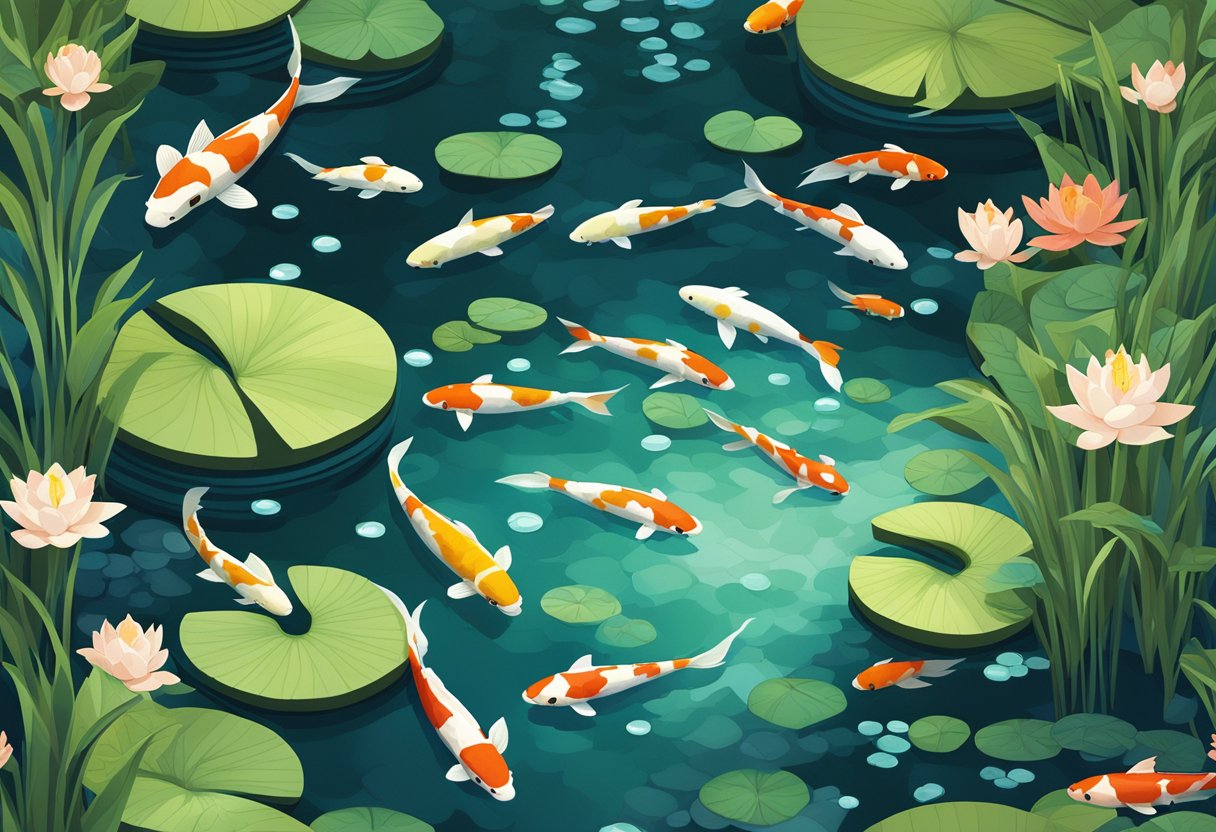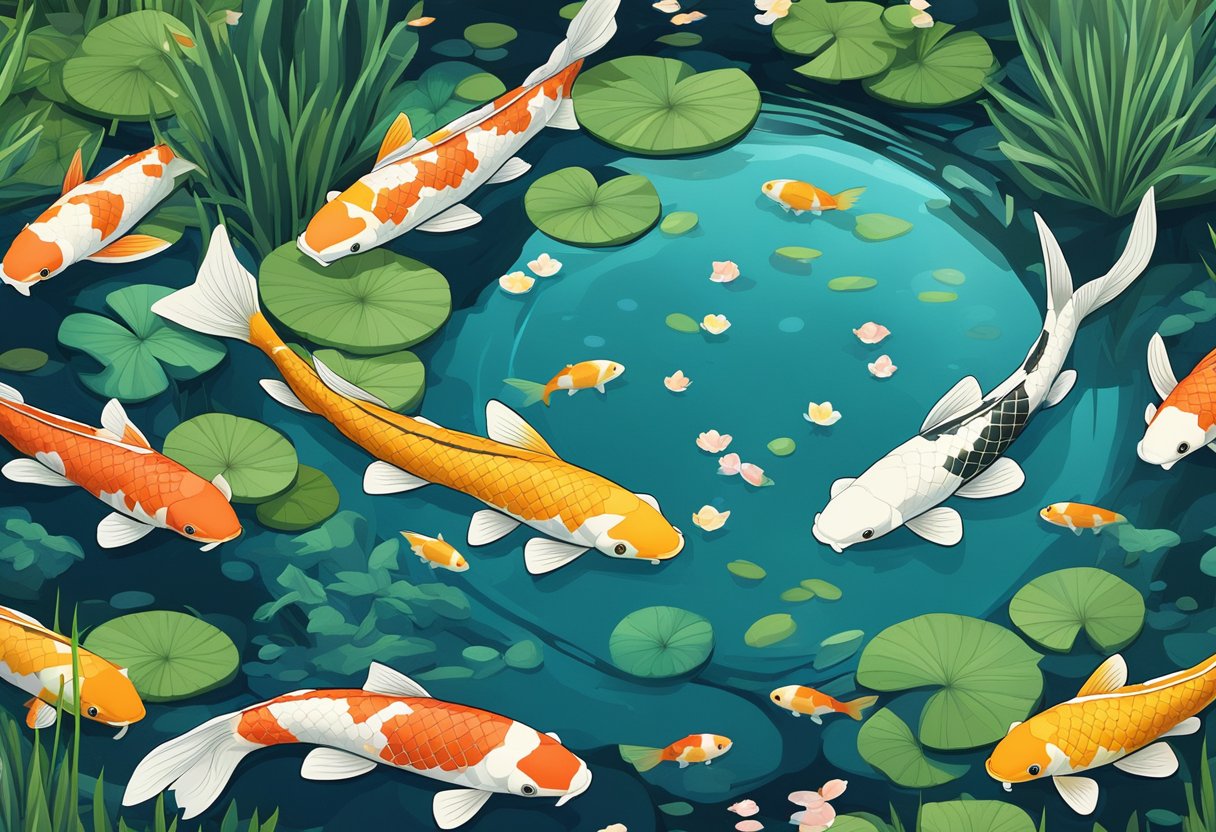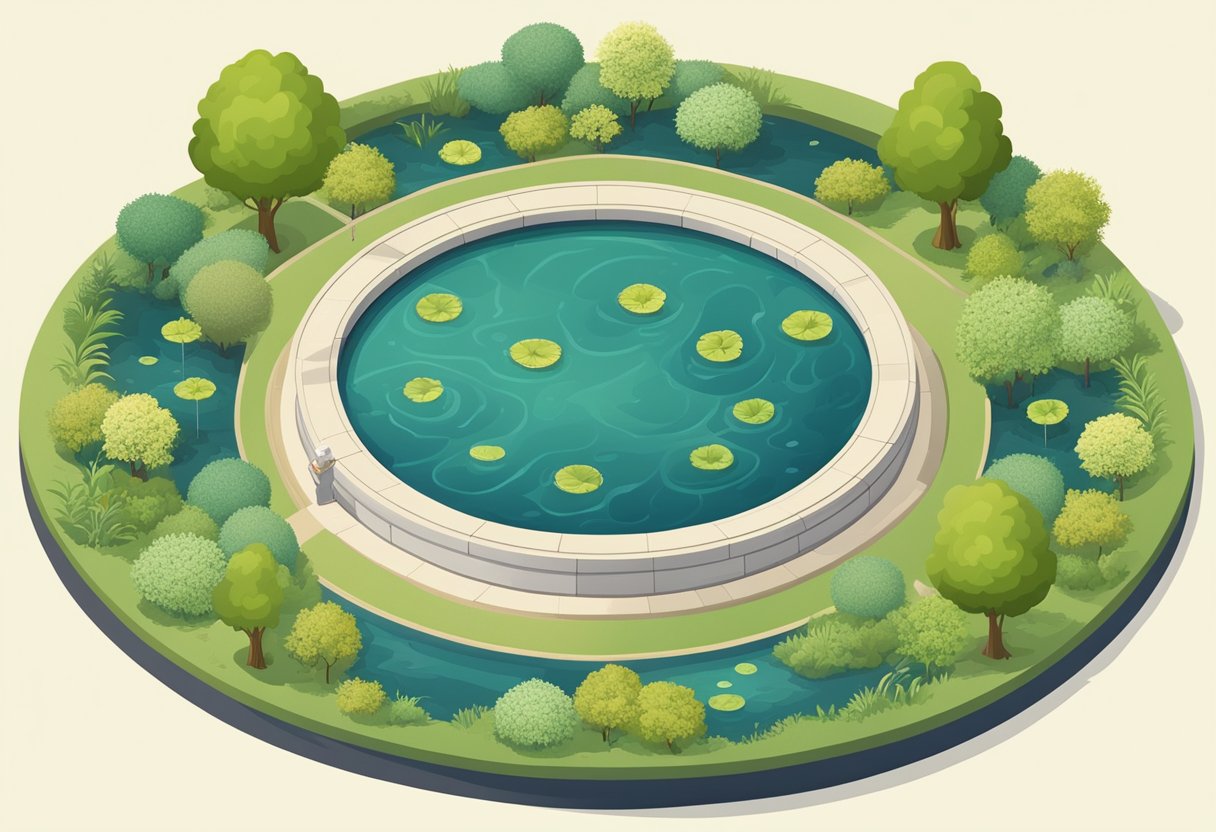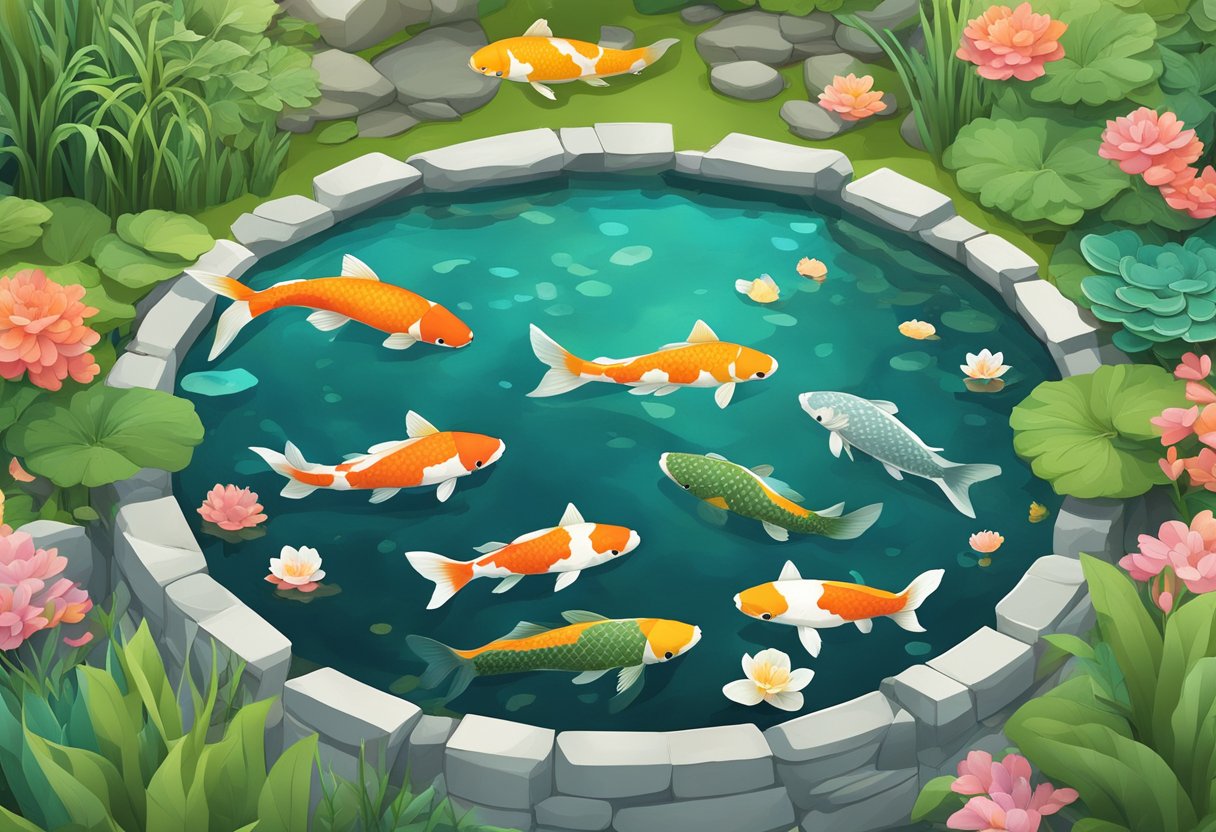The article will cover various lighting options, including LED lights, underwater lights, and spotlights. It will also provide tips on how to strategically place the lights to highlight the pond’s best features and create a visually appealing display. Additionally, readers will learn about the benefits of using energy-efficient lighting and how to properly maintain their lighting system to ensure it lasts for years to come. By the end of the article, readers will have all the knowledge they need to create a stunning and functional lighting system for their DIY koi pond.
Understanding Pond Lighting Essentials

When it comes to lighting up your DIY Koi pond, there are a few essential things to keep in mind. Understanding the types of pond lights available, lighting techniques, and safety considerations will help you achieve a professional-looking pond that is both functional and aesthetically pleasing.
Types of Pond Lights
There are several types of pond lights to choose from, each with its own unique features and benefits. Some of the most common types of pond lights include:
- Submersible Pond Lights: These lights are designed to be completely submerged in water and are ideal for illuminating the bottom of the pond or highlighting specific features such as waterfalls or fountains.
- Floating Pond Lights: These lights float on the surface of the water and are perfect for creating a soft, ambient glow. They are often used to illuminate the perimeter of the pond or to highlight specific areas such as plants or sculptures.
- LED Pond Lights: LED lights are energy-efficient and long-lasting, making them a popular choice for pond lighting. They are available in a variety of colors and can be used to create stunning visual effects.
Lighting Techniques
Once you have chosen the type of pond lights you want to use, it’s important to consider the lighting techniques you will use to achieve the desired effect. Some popular lighting techniques include:
- Uplighting: This technique involves placing lights at the base of plants or other features to illuminate them from below. It creates a dramatic effect and is ideal for highlighting tall plants or trees.
- Silhouetting: Silhouetting involves placing lights behind objects to create a shadow effect. It’s a great way to add depth and interest to your pond.
- Spot Lighting: Spot lighting involves placing lights in specific locations to highlight certain features such as a waterfall or fountain. It’s a great way to draw attention to specific areas of your pond.
Safety Considerations
When installing pond lighting, it’s important to keep safety in mind. Here are a few things to consider:
- Use only lights that are specifically designed for use in water.
- Make sure all electrical connections are properly sealed and protected from water.
- Use a ground fault circuit interrupter (GFCI) to prevent electrical shock.
By understanding these pond lighting essentials, you can create a beautiful and safe DIY Koi pond that will be the envy of your neighborhood.
Designing Your Pond Lighting Scheme

Creating a Lighting Plan
Before you start adding lights to your koi pond, it’s important to have a plan in place. Consider the overall design of your pond and the surrounding landscape, as well as the areas you want to highlight with lighting.
Start by sketching out a rough plan of your pond and the areas you want to illuminate. Then, determine the type of lighting that will best suit your needs. For example, underwater lights can highlight the beauty of your koi fish, while spotlights can draw attention to waterfalls or other features.
Another important factor to consider is the amount of light you need. Too much light can be overwhelming and may harm your fish, while too little light can make it difficult to see your pond at night.
Choosing the Right Fixtures
Once you have a lighting plan in place, it’s time to choose the right fixtures for your pond. Consider the following factors when selecting your fixtures:
- Waterproofing: Make sure your fixtures are waterproof and designed for use in outdoor environments.
- Wattage: Choose fixtures with wattage appropriate for your pond size and lighting needs.
- Color: Consider the color of the light emitted by your fixtures. White light can create a natural look, while colored lights can add a unique touch to your pond.
- Energy efficiency: Look for fixtures that are energy-efficient to save on electricity costs.
Remember to also consider the placement of your fixtures. Avoid placing lights too close to the water’s surface or in areas where they may be easily damaged. With the right planning and fixture selection, you can create a beautiful lighting scheme that highlights the beauty of your koi pond.
Installation of Pond Lighting
Electrical Setup
Before installing pond lighting, it is important to ensure that the electrical setup is safe and secure. It is recommended to hire a licensed electrician to install a ground fault circuit interrupter (GFCI) outlet near the pond. This will help prevent electrical shock and damage to the lighting system.
Positioning Your Lights
When positioning your lights, it is important to consider the size and shape of your pond. For smaller ponds, one or two lights may be sufficient, but for larger ponds, additional lights may be necessary. It is recommended to place lights around the perimeter of the pond to create a beautiful and even glow.
Waterproofing and Cabling
Pond lighting should be waterproof to prevent damage from water exposure. It is recommended to use lighting fixtures specifically designed for ponds and to ensure that all cables are properly sealed and protected from the elements. When running cables, it is important to avoid placing them near the edge of the pond where they may be accidentally cut or damaged.
By following these simple steps, you can install pond lighting like a pro and create a stunning and safe environment for your koi fish.
Maintenance and Troubleshooting
Routine Maintenance
To ensure that the lighting system of your DIY koi pond is functioning at its best, regular maintenance is essential. Here are some routine maintenance tasks that you should perform:
- Clean the lights and lenses to remove any dirt or debris that may have accumulated over time. Use a soft cloth or sponge and a mild cleaning solution to avoid scratching the surface of the lens.
- Check the wiring and connections to ensure that they are secure and free of corrosion. Loose connections can cause the lights to flicker or fail to turn on.
- Inspect the transformer and power supply for any signs of damage or wear. Replace any faulty components immediately to prevent further damage to the lighting system.
- Trim any overgrown vegetation around the pond to prevent it from obstructing the light fixtures.
Performing these routine maintenance tasks will help to keep your DIY koi pond lighting system in top condition and extend its lifespan.
Troubleshooting Common Issues
Even with regular maintenance, issues with your DIY koi pond lighting system may arise. Here are some common problems and their possible solutions:
- Lights not turning on: Check the power supply and transformer to ensure that they are functioning properly. If the power supply is not providing the correct voltage, the lights may not turn on. Also, check the wiring and connections to ensure that they are secure and free of damage.
- Flickering lights: Loose connections or a faulty transformer can cause the lights to flicker. Check the connections and replace any faulty components.
- Dim lights: If the lights are dim, it may be due to a faulty transformer or power supply. Check the voltage output of the transformer and replace it if necessary.
- Water damage: If the light fixtures are not waterproof, they can become damaged by exposure to water. Replace any damaged fixtures immediately to prevent further damage to the lighting system.
By troubleshooting common issues and performing routine maintenance, you can keep your DIY koi pond lighting system working like a pro.
Enhancing Your Koi Pond With Lighting Accessories
Lighting is an essential aspect of any koi pond, not only for aesthetic purposes but also to provide visibility and safety. With the right lighting accessories, you can make your DIY koi pond look like it was professionally designed. Here are some lighting accessories that can enhance your koi pond:
Adding Color and Effects
Colored lights and effects can create a stunning visual display that will make your koi pond stand out. LED lights are a popular choice for adding color and effects to a koi pond. They are energy-efficient, long-lasting, and come in various colors and effects such as fading, flashing, and strobing.
Another option is to use underwater color-changing lights that can be controlled remotely. They can be programmed to change colors, brightness, and effects, creating a dynamic and mesmerizing display.
Smart Controls and Automation
Smart controls and automation allow you to control your koi pond’s lighting remotely, making it more convenient and efficient. You can set the lights to turn on and off automatically, adjust the brightness and color, and even sync them with music or other sound effects.
One example of a smart control system is a Wi-Fi-enabled controller that can be accessed through a mobile app. It allows you to adjust the lighting from anywhere, set schedules, and create custom scenes.
In conclusion, lighting accessories can enhance the beauty and safety of your DIY koi pond. By adding color and effects and using smart controls and automation, you can create a stunning visual display that will make your koi pond stand out.
Final Words
Lighting up a DIY Koi pond is not as difficult as it may seem. With the right tools and techniques, anyone can create a stunning and functional lighting system for their pond.
It is important to remember that safety should always come first when dealing with electricity and water. Always consult with a professional electrician if you are not confident in your own abilities.
When choosing your lighting fixtures, consider the size and depth of your pond, as well as the type of fish and plants you have. LED lights are a popular option due to their energy efficiency and long lifespan.
Don’t be afraid to get creative with your lighting design. Use a combination of spotlights, underwater lights, and accent lighting to create a dynamic and visually appealing display.
Finally, remember to maintain your lighting system regularly to ensure it continues to function properly. Replace any damaged or burnt out bulbs, and clean your fixtures to prevent a buildup of algae or debris.
By following these tips and tricks, you can light up your DIY Koi pond like a pro and enjoy its beauty day and night.
Frequently Asked Questions
What are the best lighting techniques for enhancing a koi pond’s visual appeal?
There are several lighting techniques that can enhance the visual appeal of a koi pond. One popular technique is to use submersible LED lights to illuminate the pond from below. This creates a beautiful shimmering effect on the water surface and highlights the colors and patterns of the koi fish. Another technique is to use spotlights or floodlights to illuminate specific features of the pond, such as waterfalls or rock formations. This creates a dramatic effect and draws attention to these features.
Can underwater lighting have an impact on koi fish health and behavior?
Underwater lighting can have a positive impact on koi fish health and behavior. It can stimulate their natural behaviors and help them to feel more comfortable in their environment. However, it is important to use the right type of lighting and to avoid overexposure. Too much light can cause stress and disrupt the natural rhythms of the fish. It is recommended to use low-wattage LED lights and to limit the duration of exposure to no more than 8 hours per day.
What are the optimal positions for lights in a koi pond to maximize aesthetic effect?
The optimal positions for lights in a koi pond depend on the desired aesthetic effect. For a natural look, it is best to position the lights in a way that mimics the natural light patterns of the sun. This means placing the lights at an angle to create shadows and depth. For a more dramatic effect, spotlights or floodlights can be positioned to highlight specific features of the pond. It is important to avoid placing lights too close to the surface of the water, as this can cause glare and reduce the visibility of the fish.
How do you safely install electrical lighting in a wet environment like a koi pond?
Installing electrical lighting in a wet environment like a koi pond requires special precautions to ensure safety. It is important to use waterproof fixtures and wiring that are designed for outdoor use. All electrical components should be installed by a licensed electrician and protected by a ground fault circuit interrupter (GFCI). It is also important to regularly inspect and maintain the lighting system to ensure that it is functioning properly and not posing a risk to the fish or humans.

As a dedicated veterinarian and animal enthusiast, I, Phoebe Wright, bring a unique perspective to my writing about Koi Fish. With my expertise in animal care, I strive to share valuable insights in a friendly and approachable manner, making my posts both informative and enjoyable to read.







